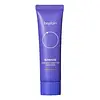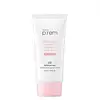What's inside
What's inside
 Key Ingredients
Key Ingredients

 Benefits
Benefits

 Concerns
Concerns

No concerns
 Ingredients Side-by-side
Ingredients Side-by-side

Water
Skin ConditioningEthylhexyl Triazone
UV AbsorberDibutyl Adipate
EmollientPropanediol
SolventDiethylamino Hydroxybenzoyl Hexyl Benzoate
UV FilterButyloctyl Salicylate
Skin ConditioningNiacinamide
SmoothingBis-Ethylhexyloxyphenol Methoxyphenyl Triazine
Skin ConditioningCI 77891
Cosmetic ColorantCoco-Caprylate/Caprate
Emollient1,2-Hexanediol
Skin ConditioningPolyglyceryl-3 Methylglucose Distearate
EmulsifyingCI 77007
Cosmetic ColorantTromethamine
BufferingDaucus Carota Sativa Root Extract
Skin ConditioningSilica
AbrasiveCarbomer
Emulsion StabilisingAmmonium Acryloyldimethyltaurate/Vp Copolymer
Acrylates/C10-30 Alkyl Acrylate Crosspolymer
Emulsion StabilisingPolyacrylate Crosspolymer-6
Emulsion StabilisingVp/Eicosene Copolymer
Stearyl Alcohol
EmollientCetyl Alcohol
EmollientEthylhexylglycerin
Skin ConditioningPolyglyceryl-6 Polyhydroxystearate
EmulsifyingPolyglyceryl-6 Polyricinoleate
EmulsifyingAluminum Hydroxide
EmollientKaolin
AbrasiveAllantoin
Skin ConditioningTriethoxycaprylylsilane
Adenosine
Skin ConditioningSodium Stearoyl Glutamate
CleansingPolyglycerin-6
HumectantSaccharide Hydrolysate
HumectantBetaine
HumectantCamellia Sinensis Leaf Water
MaskingT-Butyl Alcohol
PerfumingMyristyl Alcohol
EmollientLauryl Alcohol
EmollientTocopherol
AntioxidantAscorbyl Palmitate
AntioxidantWater, Ethylhexyl Triazone, Dibutyl Adipate, Propanediol, Diethylamino Hydroxybenzoyl Hexyl Benzoate, Butyloctyl Salicylate, Niacinamide, Bis-Ethylhexyloxyphenol Methoxyphenyl Triazine, CI 77891, Coco-Caprylate/Caprate, 1,2-Hexanediol, Polyglyceryl-3 Methylglucose Distearate, CI 77007, Tromethamine, Daucus Carota Sativa Root Extract, Silica, Carbomer, Ammonium Acryloyldimethyltaurate/Vp Copolymer, Acrylates/C10-30 Alkyl Acrylate Crosspolymer, Polyacrylate Crosspolymer-6, Vp/Eicosene Copolymer, Stearyl Alcohol, Cetyl Alcohol, Ethylhexylglycerin, Polyglyceryl-6 Polyhydroxystearate, Polyglyceryl-6 Polyricinoleate, Aluminum Hydroxide, Kaolin, Allantoin, Triethoxycaprylylsilane, Adenosine, Sodium Stearoyl Glutamate, Polyglycerin-6, Saccharide Hydrolysate, Betaine, Camellia Sinensis Leaf Water, T-Butyl Alcohol, Myristyl Alcohol, Lauryl Alcohol, Tocopherol, Ascorbyl Palmitate
Water
Skin ConditioningZinc Oxide
Cosmetic ColorantCyclohexasiloxane
EmollientCaprylyl Methicone
Skin ConditioningButyloctyl Salicylate
Skin ConditioningPropanediol
SolventPropylheptyl Caprylate
EmollientPolyglyceryl-3 Polydimethylsiloxyethyl Dimethicone
Skin ConditioningDicaprylyl Carbonate
EmollientNiacinamide
SmoothingMethyl Trimethicone
Skin ConditioningCalamine
AbsorbentMethyl Methacrylate Crosspolymer
Pyrus Communis Fruit Extract
Skin ConditioningPrunus Persica Fruit Extract
AbrasiveAvena Sativa Kernel Extract
AbrasiveCynara Scolymus Leaf Extract
Skin ConditioningCucumis Melo Fruit Extract
Skin ConditioningHedera Helix Leaf/Stem Extract
AntimicrobialFicus Carica Fruit Extract
HumectantCentella Asiatica Extract
CleansingMoringa Oleifera Seed Extract
Skin ConditioningCardiospermum Halicacabum Flower/Leaf/Vine Extract
Skin ConditioningRosmarinus Officinalis Leaf Extract
AntimicrobialRosa Damascena Flower Water
MaskingSodium Hyaluronate
HumectantJasminum Officinale Flower Water
MaskingCamellia Sinensis Leaf Water
MaskingHydrogenated Lecithin
EmulsifyingRibes Nigrum Seed Oil
EmollientHelianthus Annuus Seed Oil
EmollientDisteardimonium Hectorite
StabilisingMagnesium Sulfate
Triethoxycaprylylsilane
Panthenol
Skin ConditioningLauryl Polyglyceryl-3 Polydimethylsiloxyethyl Dimethicone
Skin ConditioningPolyglyceryl-2 Dipolyhydroxystearate
Skin ConditioningPolymethylsilsesquioxane
Methylpropanediol
SolventGlycerin
HumectantGlyceryl Caprylate
EmollientCaprylyl Glycol
EmollientEthylhexylglycerin
Skin ConditioningAdenosine
Skin ConditioningPolyquaternium-51
Skin ConditioningBeta-Glucan
Skin ConditioningCyanocobalamin
Skin ConditioningTocopherol
AntioxidantButylene Glycol
HumectantHydrolyzed Hyaluronic Acid
HumectantOctyldodecanol
EmollientMaltodextrin
AbsorbentCeramide NP
Skin ConditioningCitric Acid
BufferingHelianthus Annuus Seed Oil Unsaponifiables
EmollientWater, Zinc Oxide, Cyclohexasiloxane, Caprylyl Methicone, Butyloctyl Salicylate, Propanediol, Propylheptyl Caprylate, Polyglyceryl-3 Polydimethylsiloxyethyl Dimethicone, Dicaprylyl Carbonate, Niacinamide, Methyl Trimethicone, Calamine, Methyl Methacrylate Crosspolymer, Pyrus Communis Fruit Extract, Prunus Persica Fruit Extract, Avena Sativa Kernel Extract, Cynara Scolymus Leaf Extract, Cucumis Melo Fruit Extract, Hedera Helix Leaf/Stem Extract, Ficus Carica Fruit Extract, Centella Asiatica Extract, Moringa Oleifera Seed Extract, Cardiospermum Halicacabum Flower/Leaf/Vine Extract, Rosmarinus Officinalis Leaf Extract, Rosa Damascena Flower Water, Sodium Hyaluronate, Jasminum Officinale Flower Water, Camellia Sinensis Leaf Water, Hydrogenated Lecithin, Ribes Nigrum Seed Oil, Helianthus Annuus Seed Oil, Disteardimonium Hectorite, Magnesium Sulfate, Triethoxycaprylylsilane, Panthenol, Lauryl Polyglyceryl-3 Polydimethylsiloxyethyl Dimethicone, Polyglyceryl-2 Dipolyhydroxystearate, Polymethylsilsesquioxane, Methylpropanediol, Glycerin, Glyceryl Caprylate, Caprylyl Glycol, Ethylhexylglycerin, Adenosine, Polyquaternium-51, Beta-Glucan, Cyanocobalamin, Tocopherol, Butylene Glycol, Hydrolyzed Hyaluronic Acid, Octyldodecanol, Maltodextrin, Ceramide NP, Citric Acid, Helianthus Annuus Seed Oil Unsaponifiables
Ingredients Explained
These ingredients are found in both products.
Ingredients higher up in an ingredient list are typically present in a larger amount.
Adenosine is in every living organism. It is one of four components in nucleic acids that helps store our DNA.
Adenosine has many benefits when used. These benefits include hydrating the skin, smoothing skin, and reducing wrinkles. Once applied, adenosine increases collagen production. It also helps with improving firmness and tissue repair.
Studies have found adenosine may also help with wound healing.
In skincare products, Adenosine is usually derived from yeast.
Learn more about AdenosineButyloctyl Salicylate is a chemical UV filter structurally similar to octisalate. It is a photostabilizer, SPF booster, emollient and solvent. This ingredient helps evenly spread out ingredients.
According to a manufacturer, it is suitable for pairing with micro Titanium Dioxide, Zinc Oxide, and pigments.
Photostabilizers help stabilize UV-filters and prevents them from degrading quickly.
Learn more about Butyloctyl SalicylateCamellia Sinensis Leaf Water is a tonic and helps with masking.
Tonics are used to remove soap residues. They also help moisturize the skin.
Masking ingredients are used to obscure or block properties of other ingredients. They are commonly used to block the scent of a product.
Camellia Sinensis leaves contain antioxidants, anti-inflammatory, and anti-microbial properties.
Learn more about Camellia Sinensis Leaf WaterEthylhexylglycerin (we can't pronounce this either) is commonly used as a preservative and skin softener. It is derived from glyceryl.
You might see Ethylhexylglycerin often paired with other preservatives such as phenoxyethanol. Ethylhexylglycerin has been found to increase the effectiveness of these other preservatives.
Niacinamide is a multitasking form of vitamin B3 that strengthens the skin barrier, reduces pores and dark spots, regulates oil, and improves signs of aging.
And the best part? It's gentle and well-tolerated by most skin types, including sensitive and reactive skin.
You might have heard of "niacin flush", or the reddening of skin that causes itchiness. Niacinamide has not been found to cause this.
In very rare cases, some individuals may not be able to tolerate niacinamide at all or experience an allergic reaction to it.
If you are experiencing flaking, irritation, and dryness with this ingredient, be sure to double check all your products as this ingredient can be found in all categories of skincare.
When incorporating niacinamide into your routine, look out for concentration amounts. Typically, 5% niacinamide provides benefits such as fading dark spots. However, if you have sensitive skin, it is better to begin with a smaller concentration.
When you apply niacinamide to your skin, your body converts it into nicotinamide adenine dinucleotide (NAD). NAD is an essential coenzyme that is already found in your cells as "fuel" and powers countless biological processes.
In your skin, NAD helps repair cell damage, produce new healthy cells, support collagen production, strengthen the skin barrier, and fight environmental stressors (like UV and pollution).
Our natural NAD levels start to decline with age, leading to slower skin repair, visible aging, and a weaker skin barrier. By providing your skin niacinamide, you're recharging your skin's NAD levels. This leads to stronger, healthier, and younger looking skin.
Another name for vitamin B3 is nicotinamide. This vitamin is water-soluble and our bodies don't store it. We obtain Vitamin B3 from either food or skincare. Meat, fish, wheat, yeast, and leafy greens contain vitamin B3.
The type of niacinamide used in skincare is synthetically created.
Learn more about NiacinamidePropanediol is an all-star ingredient. It softens, hydrates, and smooths the skin.
It’s often used to:
Propanediol is not likely to cause sensitivity and considered safe to use. It is derived from corn or petroleum with a clear color and no scent.
Learn more about PropanediolTocopherol (also known as Vitamin E) is a common antioxidant used to help protect the skin from free-radicals and strengthen the skin barrier. It's also fat soluble - this means our skin is great at absorbing it.
Vitamin E also helps keep your natural skin lipids healthy. Your lipid skin barrier naturally consists of lipids, ceramides, and fatty acids. Vitamin E offers extra protection for your skin’s lipid barrier, keeping your skin healthy and nourished.
Another benefit is a bit of UV protection. Vitamin E helps reduce the damage caused by UVB rays. (It should not replace your sunscreen). Combining it with Vitamin C can decrease sunburned cells and hyperpigmentation after UV exposure.
You might have noticed Vitamin E + C often paired together. This is because it is great at stabilizing Vitamin C. Using the two together helps increase the effectiveness of both ingredients.
There are often claims that Vitamin E can reduce/prevent scarring, but these claims haven't been confirmed by scientific research.
Learn more about TocopherolTriethoxycaprylylsilane is a silicone used to bind and stabilize ingredients.
As an emulsifier, it helps prevent ingredients from separating. This can help elongate the shelf life of products.
Triethoxycaprylylsilane is often used to coat mineral sunscreens ingredients to help give a better feel. It also helps reduce oxidative stress in sunscreens.
Learn more about TriethoxycaprylylsilaneWater. It's the most common cosmetic ingredient of all. You'll usually see it at the top of ingredient lists, meaning that it makes up the largest part of the product.
So why is it so popular? Water most often acts as a solvent - this means that it helps dissolve other ingredients into the formulation.
You'll also recognize water as that liquid we all need to stay alive. If you see this, drink a glass of water. Stay hydrated!
Learn more about Water